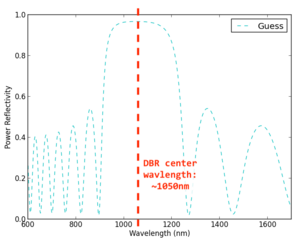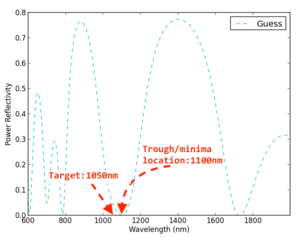IBD: Calibrating Optical Thickness
Jump to navigation
Jump to search
Basic method for calibrating optical thickness, for DBR/multi-layer optical coatings (2 alternating films only). Commonly used for SiO2/TaO DBR mirrors/filters.
- Get dep rate & refractive index (RIX) of individual SiO and TaO films, using single-deps and J.A. Woolam Ellipsometer or equivalent tool. Approx. rate from previous user is also acceptable.
- Get RIX at the target wavelength, using "Derived Params" on JAW or Cauchy equation A/B/C params. For example, if targeting a DBR centered at 1550nm (target λ=1550nm), you will want to know the RIX at 1550nm specifically.
- Calculate approximate dep. time to achieve a 1/4-wave thickness at the target wavelength, for each film (SiO and TaO).
- For example, if the dep. rate of SiO2 measured at 5.2nm/min and RIX is n1550 = 1.494, then
- SiO 1/4λ thickness: d1/4λ = 1550nm / 4 / 1.494 = 259.4nm
- SiO 1/4λ time: t1/4λ = 259.4nm ÷ 5.2nm/min = 49.88min = 2993.077 sec
- (and then do the same for TaO)
- Deposit a fabry-perot 1/2-λ of one film (SiO or TaO) cavity onto a Silicon piece, using the above 1/4-λ deposition times (aka. "SiO/4" or "TaO/4" in the following), to calibrate that film's optical-thickness.
- eg. for SiO Fabry-Perot cavity (aka. SiO-FP):
- SiO/4 + TaO/4 + SiO/4 + TaO/4 + SiO/4 + TaO/4 + (SiO/4 + SiO/4) + TaO/4 + SiO/4 + TaO/4 + SiO/4 + TaO/4
- Here we used only 3 periods of DBR on either side of the 1/2-λ cavity, to speed up the deposition.
- Measure the reflectivity on Filmetrics F10-RT.
- Locate the wavelength of the minimum (dip) in the optical spectrum. Spectrum will typically be very broad, due to omitting many of the surrounding DBR layers for speed.
- For example, the trough might show a minimum at 1600nm instead of the targeted 1550nm.
- Correct the film's optical thickness as so:
- t1/4λ * λtarget / λmeasured = corrected t1/4λ
- 2993.077 sec * (1550nm / 1600nm) = 2899.543 sec for SiO/4 layers
- Use this corrected time for all SiO/4 layers.
- You only need to edit the One "SiO2_dep" step in the IBD recipe, which will also change all "SiO2_dep" steps in the recipe.
- Do the same Fabry-Perot correction for the other film, in this case do an "TaO-FP", and apply the new TaO/4 time to the recipe.
- Perform a test-DBR deposition onto Silicon, eg. 9 periods (less than full, which could be 15 periods or more), and measure on Filmetrics F10-RT, to confirm that center wavelength is in the right spot. An example DBR test-dep targeting 1050nm looks like this:

Example reflectivity spectra of the 9-period DBR test-dep. - Perform full-DBR deposition onto production parts. Include a flat Silicon witness for measuring the final DBR reflectivity spectrum.
- Sources of error: thick, stressy films exhibit the stress-optic effect, in which compressed films (closer to the substrate) will often show a reduction in RIX. In going from a 9-period DBR to a 18-period DBR, you might see a ~10-20nm blue-shift. Some users for whom such a shift is outside the device tolerance will do a full DBR dep, then apply a % reduction to all dep times to further dial in the DBR reflectivity band.
- The same method can be used to calibrate optical-thickness for arbitrary multi-layer optical filters.
Note, you can verify/better understand the above method using any electromagnetic thin-film simulator. For example, EMpy has a simple transfer-matrix example for doing this, along with RIX models contributed by Demis. Demis created the above simulations using EMpy.
Developed by Demis D. John, Bob Farrell, Dustin Kleckner, ~2008-2010. This is the same method used by UCSB VCSEL groups years earlier, for calibrating VCSEL MOCVD/MBE growths. Please consider our publication policy if you publish papers using this information.
